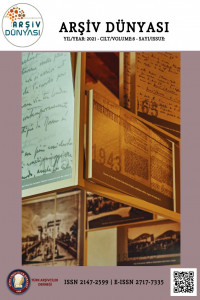Editörden
Hakemli Makaleler
İnceleme Yazıları
Tanıtım-Değerlendirme
Editöre Mektup
Sayı Editör Kurulu

 0000-0003-2393-5207
0000-0003-2393-5207





Amaç ve Kapsam
Bilgi ve Belge Yönetimi, Arşivcilik, Kütüphanecilik, tarihi devlet arşivleri, tarih incelemeleri, sosyal bilimler, enformasyon sistemleri gibi alanlarda özgün bilimsel makaleleri ve saha çalışmalarından elde edilen tecrübelerin yayınlanarak bilimsel çalışmaların yaygınlaşmasını sağlamaktır.
Yazım Kuralları
ARŞİV DÜNYASI YAZIM KURALLARI
Genel Kurallar
Özgün çalışmalar, MS Office Word ortamında yazılmalı; başlık, özet ve anahtar kelimeler hem Türkçe hem İngilizce olarak verilmelidir. Ana metin; giriş, yöntem, bulgular, tartışma ve sonuç bölümleri ile kaynakça ve varsa ekler bölümlerini de içermelidir. Çalışmanın birinci sayfası; sırasıyla çalışmanın başlığı, yazar bilgileri, öz, anahtar kelimeler, abstract ve keywords bölümlerini içermelidir
Sayfa yapısı, A4 formatında (genişlik: 21,0 cm; yükseklik: 29,7 cm) ve dikey olarak ayarlanmalı; kenar boşlukları üstten 3 cm, alttan 2,5 cm, soldan 3 cm ve sağdan 2,5 cm olmalıdır.
Örnek makale şablonu için tıklayınız.
Çalışma Başlığı (Türkçe)
Özgün çalışma başlığı, sayfanın en üst tarafına ortalanarak, büyük harflerle, koyu ve Times New Roman 14 punto ile yazılmalıdır.
Yazar Bilgileri
İlk yazarın unvan, ad, soyad, kurum ve e-posta bilgileri; kalın, Times New Roman 10 punto ve sağa hizalı olarak yazılmalıdır. Yazar adının sadece ilk harfi büyük, diğer harfler küçük olmalı ve soyadının tamamı büyük harflerle yazılmalıdır. Yazar adı ve soyadının altına, boşluk bırakılmadan, kurum bilgileri ve yazar e-posta adresi; Times New Roman, 9 punto, italik ve sağa hizalı olarak eklenmelidir.
Birden fazla yazar olması durumunda ise; yazarlara ait tüm bilgiler girildikten sonra 1 satır boşluk bırakıldıktan sonra diğer yazar bilgileri de ilk yazar bilgisinde olduğu gibi yazılmalıdır.
Yazar bilgileri başka bir Word sayfasında oluşturulmalı ve sisteme ana metin ile ayrı olarak yüklenmelidir. Yazar adı veya kurum bilgileri makale word dosyasına eklenmemelidir.
Yazar bilgileri Word dosyası için tıklayınız.
Telif Hakkı Devir Formu için tıklayınız.
Öz
Yazar bilgilerinden sonra, önce 0 sonra 6nk boşluk bırakılarak öz başlığı; sola hizalı, Times New Roman 11 punto ve büyük harflerle yazılır. Öz metni; önce 0nk, sonra 6nk boşluk bırakılarak, Times New Roman 9 punto, italik ve her iki yana yaslı olarak yazılmalıdır. Öz alanında en az 125 en fazla 300 kelimelik Türkçe öz olmalıdır. Araştırmanın amacı, kapsamı, araştırma soruları, yöntem, bulgular ve sonuçlar, bu alanında kısaca açıklanmalıdır.
Anahtar Kelimeler
Özgün çalışmaya ait anahtar kelimeler; Times New Roman, 8 punto, italik ve sola yaslı olarak yazılmalıdır. En az 3, en fazla 5 anahtar kelime eklenmelidir.
Çalışma Başlığı (İngilizce)
Özgün çalışma başlığının İngilizce hali, anahtar kelimelerden sonra, önce 0 sonra 6nk boşluk bırakılarak sayfanın orta kısmına ortalanıp büyük harflerle, koyu ve Times New Roman 13 punto ile yazılmalıdır.
Abstract
Abstract başlığı; İngilizce çalışma başlığından sonra, önce 0 sonra 6nk boşluk bırakılarak Times New Roman 11 punto ve büyük harflerle sola hizalı olarak yazılmalıdır. Abstract metni; Times New Roman 9 punto, italik ve her iki yana yaslı olarak yazılmalıdır. Abstract alanında Türkçe özün anlamlı İngilizce çevirisi yer almalıdır.
Keywords
Özgün çalışmaya ait İngilizce anahtar kelimeler; 8 punto, italik ve sola yaslı olarak yazılmalıdır. En az 3, en fazla 5 anahtar kelime eklenmelidir.
Ana Metin
Özgün çalışmanın ana metni, Giriş bölümü ile ikinci sayfadan itibaren başlamalıdır. Giriş başlığı; Times New Roman, 12 Punto, büyük harf ve kalın olarak sola hizalı, önce 0nk sonra 12nk boşluk bırakılarak yazılmalıdır. Ana metin; Times New Roman 11 punto ve her iki yana yaslı ve normal stilde yazılmalı; paragraflara girinti boşluğu verilmemelidir. Paragraf öncesi ve sonrası 6nk boşluk bırakılmalı; son paragraftan sonra ise 18 nk boşluk eklenmelidir. Doğrudan alıntılar tırnak içinde verilmeli; beş satırdan az alıntılar satır arasında, beş satır ve daha uzun alıntılar ise satırın sağından ve solundan birer santimetre içeride, blok olarak ve tek satır aralığıyla yazılmalıdır. Metin içinde, dipnotlar sadece açıklamalar için kullanılmalıdır.
Başlıklar
Metinde bulunan tüm ana bölüm başlıkları; Times New Roman, 12 Punto, büyük harf ve kalın, önce 0nk, sonra 12nk boşluk bırakılarak sola hizalı yazılmalıdır. Alt bölüm başlıkları; Times New Roman 11 punto, ilk harfler büyük, koyu, italik ve sola hizalanmış bir şekilde ayarlanmalı ve önce 0nk, sonra 12nk boşluk bırakılmalıdır. Giriş, bölüm başlıkları, alt başlıklar ve sonuç bölümleri numaralandırılmamalıdır.Tablolar
Ana metin içerisinde tablolar 1’den itibaren numaralandırılmalıdır. Tablo başlıkları tablonun üst tarafına ortalanarak konumlandırılmalı; ilk harfler büyük, diğer harfler küçük olacak şekilde koyu olarak yazılmalıdır. Tablonun varsa kaynağı, Times New Roman 9 punto olarak tablo başlığının altında boşluk bırakılmadan belirtilmelidir.
Grafik ve Şekiller
Ana metin içerisinde grafik ve şekiller 1’den itibaren numaralandırılmalıdır. Grafik ve şekil başlıkları; grafik veya şeklin alt tarafına ortalanarak konumlandırılmalı; ilk harfler büyük, diğer harfler küçük olacak şekilde koyu olarak yazılmalıdır. Grafik veya şeklin varsa kaynağı, Times New Roman 9 punto olarak tablo başlığının altında boşluk bırakılmadan belirtilmelidir.
Atıf Düzeni
Çalışmadaki alıntılar metin içi alıntılama yöntemi ile yapılmalıdır. Atıf için ana kılavuz APA (Amerikan Psikoloji Derneği) 6. baskıdır.
● Tek Yazarlı Eser
(Soyadı, Yıl, Sayfa Numarası. ). Örnek: (Yalçınkaya, 2012, s. 1).
● İki Yazarlı Eser
(Birinci Yazar Soyadı ve İkinci Yazar Soyadı, Yıl, Sayfa Numarası. ). Örnek: (Ünal ve Özdemirci, 2017, s. 60).
● Üç ve Daha Fazla Yazarlı Eser
İlk Atıf: (Birinci Yazar Soyadı, İkinci Yazar Soyadı ve Üçüncü Yazar Soyadı, Yıl, Sayfa Numarası. ) Örnek: (Kakırman Yıldız, Yalçınkaya ve Saydam, 2017, s. 19).
Sonraki Atıflar: (Birinci Yazar Soyadı vd., 2018, s. 43).
● Altı ve Daha Fazla Yazarlı Eser
İlk Atıf: (Birinci Yazar Soyadı vd., Yıl, Sayfa Numarası. ). Örnek: (Erkan vd., 2003, s. 110).
Sonraki Atıflar: (Erkan vd., 2003, s. 110).
● Tüzel Kişi Tarafından Yazılmış Eser
İlk Atıf (Kurum Adı [Kurumun Kısaltılmış Adı], Yıl, Sayfa Numarası. ). Örnek: (Aile, Çalışma ve Sosyal Güvenlik Bakanlığı [AÇSGB], 2017, s. 89)
İkinci ve Sonraki Atıflar (Kurumun Kısaltılmış Adı, Yıl, Sayfa Numarası. ). Örnek: (AÇSGB, 2017, s. 89).
● Aynı Yazarın Aynı Yıldaki Eserleri
(Yazar Soyadı, Yıl(a), Sayfa Numarası. ). Örnek: (Özdemirci, 2018(a), s. 152).
(Soyadı, Yıl(b): s. No). Örnek: (Özdemirci, 2018(b), s. 2)
● Soyadları Aynı İki Yazarın Eserleri
(Yazar Adının Baş Harfi. Soyadı, Yıl, Sayfa Numarası. ). Örnek: (D. Siyez, 2007, s. 68)
(Diğer Yazar Adının Baş Harfi. Soyadı, Yıl, Sayfa Numarası. ). Örnek: (E. Siyez, 2008, s. 89)
● Yazarı Olmayan Eser (Eserin Adı, Yıl, Sayfa Numarası. ). Örnek: (Meslekler Tercihi, 1999, s. 66)
● Yayın Tarihi Olmayan Eser (Yazar Soyadı, ty, Sayfa Numarası. ). Örnek: (Johnson, ty, s. 20)
● Birden Fazla Esere Aynı Anda Atıf (Yazar Soyadı, Yıl, Sayfa Numarası; Yazar Soyadı, Yıl, Sayfa Numarası; Yazar Soyadı, Yıl, Sayfa Numarası.). Örnek: (Cibaroğlu, 2015, s. 56; Yılmaz Şentürk, 2018, s. 106; Yalçınkaya, 2016 s. 25)
Kaynakça Düzeni
Kaynakça başlığı, Times New Roman 12 punto, kalın, büyük harf ve sola hizalı olarak yazılmalıdır. Çalışmada yararlanılan kaynaklar, Kaynakça başlığı altında, Times New Roman 11 punto, yazar soyadı alfabetik sıra ile aşağıdaki gibi yazılmalıdır. Kaynakça başlığından önce ve sonra 1 satır boşluk bırakılmalıdır. Kaynaklar arasında tek satır aralığı boşluk bırakılmalıdır.
Kitaplar
● Tek Yazarlı: Soyadı, Adının İlk Harfi. (Yayın Yılı). Kitap adı. Yayın Yeri: Yayın Evi.
Örnek: Ohler, J. (2010). Digital Community, Digital Citizen. Corwin Press: Thousand Oaks.
● İki Yazarlı: Soyadı, Adının İlk Harfi ve Soyadı, Adının İlk Harfi. (Yayın Yılı). Kitap adı. Yayın Yeri: Yayın Evi.
Örnek: Tabachnick, B. ve Fidell, L. S. (2001). Using Multivariate Statistics. Allyn and Bacon: Boston.
● Çok Yazarlı: Soyadı, Adının İlk Harfi, Soyadı, Adının İlk Harfi ve Soyadı, Adının İlk Harfi. (Yayın Yılı). Kitap adı. Yayın Yeri: Yayın Evi.
Örnek: Ranzijn, R., McConnochie, K. ve Nolan, W. (2009). Psychology and Indigenous Australians: Foundations of Cultural Competence. Victoria: Palgrave Macmillan.
● Tüzel kişi Yazarlı: Tüzel kişi (Yayın Yılı). Kitap adı. Yayın Yeri: Yayın Evi.
Örnek: United Nations. (2018). e-Government Survey 2018: Gearing e-Government to Support Transformation Towards Sustainable and Resilient Societies. United Nations: New York.
● Çeviri: Soyadı, Adı (Yayın Yılı). Kitap adı (Çev. A. Soyadı). Yayın Yeri: Yayın Evi.
Örnek: Rowley, J. (1996). Bilginin Düzenlenmesi: Bilgi Erişime Giriş. (Çev. S. Karakaş, H. Ü. Can, A. Yıldızeli ve B. Kayıran). Ankara: Türk Kütüphaneciler Derneği.
● Kitap İçinde Yayın (Bölüm ya da Makale): Soyadı, Adı (Yayın Yılı). Yayın Adı. Adı Soyadı (Ed.), Kitap adı içinde, Sayfa Numaraları. Yayın Yeri: Yayın Evi.
Örnek: Onan, K., Sennaroğlu, B. (2009). Comparative Study of Production Control Systems Through Simulation. N. Mastorakis, J. Sakellaris (Ed.), Advances in Numerical Methods içinde, (67-78). New York: London: Springer.
Makaleler, Bildiriler, Diğer Basılı Yayınlar
● Bilimsel Dergi Makalesi - Tek Yazarlı: Soyadı, Adının İlk Harfi. (Yayın Yılı). Makale adı. Dergi Adı, Cilt(sayı), Sayfa Numaraları.
Örnek: Yazar, H. (2012). Bilim ve Hayat. Bilgi Dergisi, 12(2), ss. 15-25.
● Bilimsel Dergi Makalesi - Çok Yazarlı: Soyadı, Adının İlk Harfi., Soyadı, Adının İlk Harfi., Soyadı, Adının İlk Harfi., Soyadı, Adının İlk Harfi., Soyadı, Adının İlk Harfi. (Yayın Yılı). Makale Adı. Dergi adı, Cilt(sayı), Sayfa Numaraları.
Örnek: Adams, C., Buetow, S., Edlin, R., Zdravkovic, N. ve Heyligers, J. (2016). A Collaborative Approach to Integrating Information and Academic Literacy into the Curricula of Research Methods Courses. The Journal of Academic Librarianship, 42(2), 222-231.
● Bildiri - Yayımlanmış: Soyadı, Adının İlk Harfi (Yayın Yılı). Bildiri Adı. Adı Soyadı (Ed.). Kitap/Kongre/Sempozyum Adı içinde, (Sayfa Numaraları). Yayın Yeri: Yayınevi.
Örnek: Game, A. (2001). Creative Ways of Being. J. R. Morss, N. Stephenson ve J. F. H. V. Rappard (Ed.), Theoretical Issues in Psychology: Proceedings of the International Society for Theoretical Psychology 1999 Conference içinde, (3-12. ss.). Sydney: Springer.
● Danışma Kaynakları - Sözlük: Soyadı, Adının İlk Harfi. (Yayın Yılı). Eser Adı. Yayın Yeri: Yayınevi.
Örnek: Moses, R. P. (2005). A Glossary of Archival and Records Terminology. Chicago: The Society of American Archivists.
● Danışma Kaynakları - Ansiklopedi Maddesi: Soyadı, Adının İlk Harfi. (Yayın Yılı). Madde Adı. Eser Adı içinde (Baskı, Cilt, Sayfa Numaraları). Yayın Yeri: Yayınevi.
Örnek: Keyormarsi, K., O’Leary, N. ve Pardee, A. B. (2007). Cell Division. McGraw-Hill Encyclopedia of Science & Technology içinde (9. bs., Cilt 3, 618-621). New York: McGraw-Hill.
● Tez - Yayımlanmamış: Soyadı, Adının İlk Harfi. (Yayın Yılı). Tez Adı. Yüksek lisans/Doktora/Sanatta Yeterlik Tezi, Üniversite ve Enstitü Adı, Yer.
Örnek: Çetinkaya, Ş. (2015). Stochastic Mortality Using non-Life Methods. (Yayımlanmamış doktora tezi). Doğuş Üniversitesi Sosyal Bilimler Enstitüsü, İstanbul.
Elektronik Kaynaklar
● Elektronik Kaynak - Basılı Kitabın Elektronik Sürümü: Soyadı, Adı (Yayın Yılı). Kitap Adı [Elektronik Sürüm]. Yayın Yeri: Yayınevi. Erişim Adresi:
Örnek: Chisum, W. J. (2006). Crime Reconstruction [Adobe Digital Editions]. California: Elsevier. Erişim adresi: Ebook Library.
● Elektronik Kaynak - Makale: Soyadı, Adının İlk Harfi. (Yayın Yılı). Makale Başlığı. Dergi Adı, Cilt (sayı), Sayfa Numaraları. Erişim tarihi/Ağ Adresi.
Örnek: Aygören, H., Yeşilyurt, M., Güloğlu, B. ve Küçükkaplan, İ. (2015). Türk Bankacılık Sektöründe Hisse Senedi Performansı ve Etkinlik Arasındaki İlişki. Doğuş Üniversitesi Dergisi, 16(2), 203-215. 25.04.2018 tarihinde https://journal.dogus.edu.tr/ojs/index.php/duj/article/view/914 adresinden erişildi.
● Elektronik Kaynak - Tüzel Yazarlı Devlet Raporu: Kurum Adı, Alt Birim Adı. (Yıl). Rapor Adı (Rapor No). Ağ Adresi/Erişim Tarihi.
Örnek: T.C. Kalkınma Bakanlığı, Bilgi Toplumu Dairesi. (2015). 2015-2018 Bilgi toplumu stratejisi ve eylem planı (Yayın No. 2939). Erişim adresi: http://www.kalkinma.gov.tr/Lists/Yaynlar/Attachments/ 649/2015- 2018%20Bilgi%20Toplumu%20Stratejisi%20ve%20Eylem%20Plan%C4%B1.pdf
● Elektronik Kaynak – Yayımlanmış Tez: Soyadı, Adının İlk Harfi. (Yıl). Tez Adı. (Yüksek Lisans/Doktora Tezi). Erişilen veri tabanı adı. (Erişim veya Sıra Numarası). Ağ Adresi/Erişim Tarihi.
Örnek: Spencer, J. W. (1997). Firms' Strategies in the Global Innovation System: Knowledge Sharing in the Flat Panel Display Industry. (Doktora Tezi). ProQuest Dissertations & Theses Global. (Erişim Numarası: 9815072). 12.08.2015 tarihinde https://search.proquest.com/docview/304383843?accountid=13654 adresinden erişildi.
● Web Sayfası: Soyadı, Adının İlk Harfi. (Yıl, Ay, Gün). Web Sayfası Başlığı. Erişim Adresi:
Örnek: Simmons, B. (2015, January 9). The Tale of Two Flaccos. 29.05.2019 tarihinde http://grantland.com/the-triangle/the-tale-of-two-flaccos/ adresinden erişildi.
● Web Dokümanı – Tüzel Yazar: Kurum Adı, Alt Birim Adı. (Yıl). Web Sayfası Doküman Başlığı. Yayıncı. Erişim Tarihi Erişim Adresi:
Government of Dubai, Dubai Statistics Center. (2008). Population - Emirate of Dubai 2008. 12.06.2018 tarihinde Dubai Statistics Center Web Sitesi. 12.05.2018 tarihinde http://www.dsc.gov.ae/Publication/Dubai_Population_08_english.pdf adresinden erişildi.
● Blog: Soyadı, Adının İlk Harfi. (Yıl, Gün, Ay). Blog Başlığı. [Blog Türü] Erişim Adresi:
Örnek: Çelik, S. (2011, 21 Aralık). Dergilerin İndekslenmesi ve Etki Faktörü (Impact Factor). [Web Blog] Erişim adresi: https://www.sonmezcelik.net/2011/12/dergilerin-indekslenmesi-ve-etki.html
Etik İlkeler ve Yayın Politikası
ETİK İLKELER
Arşiv Dünyası olarak, Aşağıda yer alan etik sorumluluklar "Committee on Publication Ethics (COPE)" tarafından belirtilen etik kurallara ve sorumluluklara uygun olarak hazırlanmıştır. Dergi editörlerinin, hakemlerinin ve yazarlarının aşağıda yer alan etik kurallara uygun şekilde hareket etmesi beklenmektedir. Dergimiz, DergiPark platformu üzerinde hizmet vermekte ve tüm bilimsel etik kurallara uygun olarak yayınlanmaktadır.
EDİTÖRLERE YÖNELİK ETİK SORUMLULUKLAR
Dergi İçeriği İçin Sorumluluk:
Editör dergide yayımlanan her makaleden sorumludur. Yayınladıkları materyalin kalitesini sağlamak ve yayınlanmış kaydın bütünlüğünü korumak durumundadır. Bu kapsamda editör;
Yalnızca akademik olarak karar verir ve verilen bu kararlar ile ilgili tam sorumluluk alır.
Çalışmaların adil ve tarafsız şekilde değerlendirilebilmesi amacıyla düşünce özgürlüğü ilkesine uygun hareket etmeye özen gösterir.
İş süreçlerini fikri mülkiyet haklarına ve etik standartlara uygun yürütür.
Okuyucuların ve yazarların bilgi ihtiyaçlarını karşılamaya yönelik çaba sarf eder, sürekli olarak derginin gelişimini sağlamaya çalışır.
Yazarların ve hakemlerin gizliliğini korur, hakem sürecini de buna uygun yönetir.
Derginin süreçlerinin geliştirilmesi konusunda yazar, okuyucu ve hakem kurulu üyelerinin görüşlerini dikkate alır.
Hakemlik ve yayıncılıkla ilgili araştırmaları takip eder, yeni bilgiler ışığında derginin süreçlerini gözden geçirir.
Okuyucu İle İlişkiler
Editörler, yayınlanan çalışmaların özgün olmasına dikkat eder, çalışmanın okuyucu, araştırmacı ve uygulama yapan kişilere bilimsel katkı sağlamasına özen gösterir.
Editörler tüm paydaşlardan gelen geri bildirimleri dikkate alır, açıklayıcı ve bilgilendirici geri dönüş sağlamak için çaba sarf eder.
Yazarlar İle İlişkiler
Editörler, tüm çalışmaların uygun nitelikli hakemler tarafından incelenmesi konusunda özen gösterir.
Süreçlere dair yazarlara yönelik ayrıntılı bilgi, Arşiv Dünyası web sayfasında yer alan Yazım Kurallarında verilmektedir.
Sürece dair yaşanabilecek aksaklıkların önüne geçebilmek için Editör, yazar ile sürekli iletişim halinde bulunur.
Hakemler İle İlişkiler
Hakem atamaları sırasında, yazarlar ve hakemler arasından çıkar çatışması olup olmadığı editörler tarafından gözetilir.
Değerlendirme işlemi, çifte körleme yöntemiyle yürütüldüğü için hakemlerin kimlik bilgileri gizli tutulur. Her sayının hakem listesi, ilgili sayıda duyurulur.
Hakemler çalışmayı değerlendirirken tarafsız, bilimsel ve nesnel bir dil kullanılması konusunda teşvik edilir.
Hakem havuzunun farklı disiplinlerden oluşması ve sürekli olarak güncellenmesi için gerekli çalışmalar yapılır.
Nezaketsiz ve bilimsel olmayan değerlendirmeler engellenir ya da sansürlenir.
Hakemlik ve Değerlendirme Süreci
Editörler; dergi Yazım Kurallarında yer alan "Hakemlik ve Değerlendirme Süreci" politikalarını uygulamakla yükümlüdür. Bu bağlamda editörler her çalışmanın adil, tarafsız ve zamanında değerlendirme sürecinin tamamlanmasını sağlar.
Hakemler hazırladıkları raporlarda, çalışmanın yayımlanması veya yayımlanmaması durumuyla ilgili kesin bir kanaat bildirebilirler. Fakat Editör/Editör Kurulu çalışmayı değerlendiren hakemlerin benzer ve karşıt görüşleri üzerinden bir karar verebilir.
Editör/Editör Kurulu bu hususta kabul veya ret veren hakemlerin sayısına değil, hakemlerin veya yazarların argümanlarının güçlülüğüne bakar. Editör/Editör Kurulu, değerlendirme soruları evet, hayır şeklinde cevaplanmış raporlardan ziyade güçlü, gerekçeleri sunulmuş önerme içeren raporları dikkate alır.
Hakem bir çalışma yayımlandıktan sonra kendi görüşlerinin çalışmada tamamen yansıtılmadığını görebilir. Diğer hakemlerin farklı görüşte bulunmaları, Editör/Editör Kurulu'nun da bu görüşleri dikkate almış olması mümkündür. Bu durumda çalışmayı değerlendiren hakemin talebi doğrultusunda diğer hakemlerin görüşleri Editör Kurulu'nun uygun görmesi halinde kendisine gönderilebilir.
Hakemlerin önerilerine göre Editör/Editör Kurulu aşağıdaki yollardan birini izler:
Çalışmayı yayımlayabilir.
Kısmi ve önemli düzeyde değişiklik ve geliştirme yapılmış çalışmayı yayıma kabul edebilir.
Yazardan/yazarlardan hakem görüşlerine uygun olarak çalışmasını düzenlemesini isteyip yeni bir değerlendirme süreci başlatabilir.
Çalışmayı reddedebilir.
Editör Kurulu Üyeleri
Derginin gelişmesine katkıda bulunacak, uygun nitelikli editör kurulu üyelerinin belirlenmesi için özen gösterilir.
Editör Kurulu üyeleri düzenli bir şekilde gözden geçirilir.
Editör, kurul üyelerinden, derginin yönetimi ile ilgili fikirlerini alır, dergi politikalarındaki değişiklikleri bildirir ve gelecek için plan yapmak üzere, düzenli bir şeklide (örneğin yılda bir kez) danışır.
Kişisel Verilerin Korunması
Editörler; kişisel veri içeren çalışmalarda kullanılan bireylerin açık rızası olmadığı sürece çalışmayı reddeder. Ayrıca editörler; yazar, hakem ve okuyucuların bireysel verilerini korumaktan sorumludur.
Etik Kurul, İnsan ve Hayvan Hakları
Editörler; değerlendirilen çalışmalarda insan ve hayvan haklarının korunmasını sağlamaya özen gösterir. Çalışmalarda kullanılan deneklere ilişkin etik kurul onayı, deneysel araştırmalara ilişkin izinlerin olmadığı durumlarda çalışmayı reddetmekle sorumludur.
Fikri Mülkiyet Haklarının Korunması
Editörler, yayınlanan tüm makalelerin fikri mülkiyet hakkını korumakla, olası ihlallerde derginin ve yazar(lar)ın haklarını savunmakla yükümlüdür.
Yapıcılık ve Tartışmaya Açıklık
Editörler, dergide yayınlanan eserlere ilişkin eleştirileri dikkate alır ve bu eleştirilere yönelik yapıcı bir tutum sergilemeye çaba gösterir.
Şikayetler
Editörler yazar ve hakem veya okuyuculardan gelen şikayetleri dikkatlice inceleyerek açıklayıcı bir şekilde yanıt vermeye çalışır.
YAYINCININ ETİK SORUMLUKLARI
Arşiv Dünyası;
Herhangi bir şekilde yazarlardan ücret talep etmemektedir.
Yayınlanmış her makalenin mülkiyet ve telif hakkını korumaya ve her kopyanın kaydını saklamaya özen gösterir.
LİSANSLAMA VE TELİF HAKKI
Arşiv Dünyası, Creative Commons Atıf 4.0 Uluslararası Lisansı ile lisanslanmıştır.
Kullanıcılar bu lisans kapsamında, lisans sahibine atıfta bulunarak eseri dağıtabilir, kopyalayabilir, üzerinde çalışmalar yapabilir, yine sahibine atıfta bulunarak türevi çalışmalar için eseri kullanabilir.
İNTİHAL DENETİMİ
Rapor edilen araştırmalar etik kurallara uygun olarak hazırlanmalı ve metin içinde yapılan atıflar mutlaka belirtilmelidir. Dergimize gönderilen çalışmalar hakem değerlendirme süreci tamamlandıktan sonra, yayımlanmadan önce intihalin önüne geçilmesi amacıyla Ithenticate programında değerlendirilmektedir.
Benzerlik oranı üst sınırı %20' dir.
Etik Olmayan Bir Durum ile Karşılaşırsa;
Yayımlanan bir makalede önemli bir hata ya da yanlışlık fark edildiğinde ya da yukarıda bahsedilen etik sorumluluklara uygun olmayan bir davranış veya içerikle karşılaşıldığında arsivdunyasidergisi@gmail.com adresine e-posta yoluyla bildirilmesi gerekmektedir.
YAYIN POLİTİKASI
Arşiv Dünyası, hakemli ulusal bir dergi olup, her yılın Haziran-Aralık aylarında olmak üzere yılda 2 sayı olarak yayınlanmaktadır. Her bir sayıda, çifte körleme metodu ile 2 hakem tarafından değerlendirilen en fazla 10 bilimsel makale yayınlanmaktadır. Bunun dışında, hakemsiz makaleler, inceleme yazıları, röportaj, teknik not, kitap tanıtımı ve incelemesi gibi yayınlar da kabul edilmektedir.
Arşiv Dünyası; Arşivcilik, Kütüphanecilik, Belge Yönetimi, Bilgi Yönetimi, Elektronik Bilgi ve Belge Yönetimi, Tarihi Arşivler, Kültür Tarihi, Diplomatika, Müzecilik vb. teorik ve uygulamalı disiplinlerarası alanlarda gerçekleştirilen bilimsel çalışmaları kabul etmektedir.
Arşiv Dünyası'na gönderilen makaleler, farklı üniversitelerden iki hakem tarafından değerlendirilir. İki hakemden de olumsuz rapor alan makaleler yayınlanmamaktadır. Hakem değerlendirmelerinden biri olumlu, diğeri olumsuz ise, makale üçüncü bir hakeme gönderilir. Üçüncü hakemin görüşü, makalenin yayınlanmasında esastır.
Arşiv Dünyası'na gönderilen makaleler başka bir yerde yayınlanmamış veya yayınlanmak üzere gönderilmemiş olmalıdır; makale gönderiminde yazarlar bu durumu taahhüt etmiş olarak kabul edilir. Yayın ilkelerine uygun olmayan makaleler hakem değerlendirme sürecine alınmamaktadır.
Makalenin hazırlanmasında geçerli bilimsel yöntemlere uyulmalı, çalışmanın konusu, amacı, kapsamı, hazırlanma gerekçesi vb. bilgiler yeterli ölçüde ve belirli bir düzen içinde verilmelidir.
Arşiv Dünyası, Türkçe ve İngilizce dillerinde yapılmış çalışmaları kabul etmektedir. Dergiye gönderilen makaleler; tüm içerik (ana metin, tablo, şekil, kaynakça notlar vb.) dahil 25 sayfayı geçmemelidir.
Editörler tarafından ön inceleme sonucunda “Arşiv Dünyası Yazım Kuralları” ve “Yayın İlkeleri”ne uyum göstermeyen çalışmalar, yazara iade edilir.
Yayınlanmak üzere dergiye gönderilen makaleler, dergide belirtilen yazım kurallarına uygun bir şekilde hazırlanarak kaynakçalar dâhil eksiksiz olarak gönderilmelidir.
Yayınlanan makalelerde benimsenen görüşler derginin görüşü değildir, her çalışma yazarının sorumluluğundadır.
Arşiv Dünyası'na gönderilen çalışmaların “Etik Kurul Kararı” gerektiren araştırma sonuçlarının yer alması durumunda, “Etik Kurul Onay Formu”nun bir kopyasının başvuru sırasında sisteme yüklenmesi gerekmektedir.
Çalışmanın Arşiv Dünyası'na gönderilmesi, çalışmanın yayınlanması için başvuru olarak kabul edilir.
Arşiv Dünyası, açık erişim yaklaşımını benimsemektedir. Dergide yayınlanan makale ve diğer çalışmalar için, yazarlardan hiçbir şekilde ücret talep edilmemektedir. Buna ek olarak çalışmalar için yazarlara da hiçbir şekilde telif ücreti ödenmemektedir.
Dergi editör ve hakem değerlendirme süreçlerinden geçtikten sonra son kez gözden geçirilmesi amacıyla ''Erken Görünüm'' seçeneği ile kullanıma açılır. Tespit edilen eksiklik ve hatalar düzeltildikten sonra derginin yeni sayısı yayımlanır.
Dergimizde yayınlar ortalama 45 gün içerisinde tamamiyle değerlendirilip yayımlanmaya hazır hale getirilmektedir.
LİSANSLAMA VE TELİF HAKKI
Arşiv Dünyası, Creative Commons Atıf 4.0 Uluslararası Lisansı ile lisanslanmıştır. Detaylı bilgi için tıklayınız. Kullanıcılar bu lisans kapsamında, lisans sahibine atıfta bulunarak eseri dağıtabilir, kopyalayabilir, üzerinde çalışmalar yapabilir, yine sahibine atıfta bulunarak türevi çalışmalar için eseri kullanabilir. Dergi tarafından makale, yazı vb. için herhangi bir işlem ücreti talep edilmemektedir. Dergide yayımlanan yazılar için yazarlara herhangi bir ücret ödenmemektedir. Yazarlar gönderilen makale ve yazılar için telif devir formunu doldurmalıdır.
Ücret Politikası
Açık erişim yaklaşımını temel alan dergimizde yayınlanacak bilimsel makaleler ve çeşitli nitelikteki yazılar ve değerlendirme süreçleri için hiçbir şekilde ücret talep edilmemektedir.

